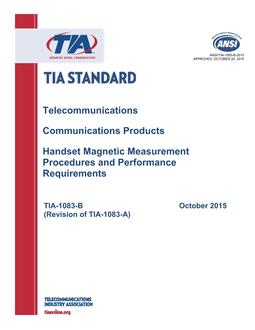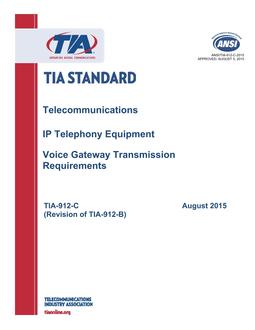-
-
Available Formats
- Availability
- Priced From ( in USD )
-
Available Formats
-
- Secure PDF 🔒
- Immediate download
-
$249.00Members pay $186.75
- Add to Cart
-
- Printed Edition
- Ships in 1-2 business days
-
$249.00Members pay $186.75
- Add to Cart
Customers Who Bought This Also Bought
-

TIA ANSI/TIA-1083-B
Priced From $123.00 -

TIA TIA/EIA/IS-129
Priced From $141.00 -

TIA ANSI/TIA-4965
Priced From $93.00 -

TIA ANSI/TIA-912-C
Priced From $184.00
About This Item
Full Description
This Standard defines a set of organizationally-specific IEEE 802.1AB TLV extensions and a related MIB module, for the purpose of improved deployment properties and multi-vendor interoperability between VoIP endpoint devices and IEEE 802 networking infrastructure elements. Where required for correct multi-vendor interoperation, specific constraints on IEEE 802.1AB protocol behavior, application-level interaction with the protocol elements, as well as constraints on existing IEEE 802.1AB TLVs and related MIB module, are also defined.
This Standard is applicable to all VoIP network edge devices such as (but not limited to) IP Phones, Voice / Media Gateways, Media Servers, IP Communications Controllers or other VoIP devices or servers, as well as to network access elements such as (but not limited to) IEEE 802 LAN Bridges or Wireless Access Points, and L2 or L3 switches or routers which are connected within IEEE 802 LANs.
This Standard specifically addresses usage of LLDP and the extensions defined herein within IEEE 802 LAN environments. This Standard may also be applicable to IEEE 802 MAN environments (IEEE 802.1AB is not specific to this, however there are no defined limits).
This Standard is specifically defined for use between VoIP endpoints and LAN network access elements, and as such is not intended for use on links between LAN infrastructure elements.
This Standard is international in scope.
This Standard conforms to and harmonizes with other existing, referenced TIA, ANSI, ISO, IEEE, IETF, ETSI, ITU-T and other standards. Specifically, this Standard conforms to IEEE 802.1AB [1] and use of the extension mechanisms defined as part of that Standard, as well as to applicable IEEEdefined pre-existing extensions to IEEE 802.1AB as published in Annexes F (802.1 extensions) and Annex G (802.3 extensions) of that Standard.
This Standard does not address interactions between IEEE 802.1AB and other link level protocols such as IEEE 802.1X or IEEE 802.3af.
This Standard is not specific to any particular VoIP control architecture, signaling or other higher-level protocol (e.g. SIP, Megaco / H.248, H.323, etc).
This Standard is not specific to any particular system management architecture, and does not mandate use of SNMP or other particular management protocol.
This Standard does not place any application-level requirements on interaction between system components such as control signaling, setting of policies, gathering of management information, or usage of the information provided.
Scope of Current Standard Release
In this release of this Standard, the following capabilities are fully specified. More detailed functional descriptions of these capabilities, as well as specific references to implementation sections, are given in section 7, Media Endpoint Discovery Functional Description.
• LAN speed and duplex in use, 2-way advertisement (see section 7.2, LAN Speed and Duplex Discovery).
• Network policy discovery, including VLAN id, 802.1p priority and Diffserv code point (DSCP), 2-way advertisement (see section 7.3, Network Policy Discovery).
• Device location and topology discovery based on LAN-level MAC/port information, 2-way advertisement (see section 7.4, LAN Level Endpoint Location Discovery).
• IP Phone location identification, including emergency call service location, based on IETF and NENA-defined location objects, 1-way advertisement from LAN infrastructure element to endpoint (see section 7.5,
• Endpoint Location Identification Discovery). Endpoint move detection notification from network connectivity device to their associated VoIP management application(s), using SNMP or similar (see section 7.6, Endpoint Move Detection Notification).
• Extended Power over Ethernet (PoE) discovery for fine-grained power management, 2-way advertisement (see section 7.7, Extended Power Via MDI Discovery).
• Extended device identification for inventory management, 1-way advertisement from endpoint to LAN infrastructure element (see section 7.8, Inventory Management Discovery).
• Identification of endpoint-embedded network connectivity capabilities (e.g. multi-port IP Phone with embedded L2 switch or bridge capability), 1-way advertisement from endpoint to LAN infrastructure element (see section 7.9, Embedded Network Connectivity Discovery).
• Application level interactions with the LLDP protocol elements to provide timely startup of LLDP to support rapid availability of Emergency Call Service (see section 7.10, LLDP-MED Fast Start Protocol Behavior).
• Applicability of LLDP-MED to Wireless LAN environments (Informative, see ANNEX B: LLDPMED Support for Voice over Wireless LAN).
Note that some of these capabilities are based on newly defined TLVs and the related MIB module defined herein, while others of these capabilities are based on previously defined TLVs and related MIB modules from the IEEE 802.1AB base specification [1].
It is considered that future iterations of this Standard can potentially add expanded support in the above or related areas, and also for other types of media endpoints, such as video devices. Refer to section 2.2 Future Considerations for a listing of future items considered, but not specified in this release of this Standard.
Future Considerations
The following were considered for inclusion in this release of this Standard, but are now considered candidates for future releases, and every effort is made to provide for extensibility to these and other capabilities:
• IP Phone advertisement of its dialable phone number, URI or other callable address.
• Extended device class definitions such as basic IP phone, video phone, web phone, etc.
• Media type(s) supported (voice, video, text conversation, etc).
• Media bandwidth requirement(s) advertise by endpoint.
• Device operational status.
• Device mobility.
• IP Phone advertisement of ECS calls in progress.
• Specific extensions for usage of LLDP-MED in Wireless LAN environments.
Purpose
This Standard fills a recognized need in the Voice Over IP (VoIP) industry, brought about by the use of equipment supplied by many different manufacturers, along with the need for cost-effective, readily deployable, and easily managed solutions. In particular, the needs for deployment of VoIP equipment into IEEE 802 - based LAN environments are addressed. It will be useful to anyone engaged in the manufacture of VoIP equipment and related products, as well as to those purchasing, operating or using such products. It is internationally applicable.
To fulfill these needs, this Standard provides extensions to IEEE 802.1AB that are specific to the requirements of Media Endpoint Devices in an IEEE 802 LAN environment. Specific usage of the IEEE 802.1AB LLDP base specification is also defined. Interaction behavior between the Media Endpoint Devices and the LAN infrastructure elements are also described where they are relevant to correct operation or multi-vendor interoperability.
LLDP extensions and behavior requirements are described specifically in the areas of network configuration and policy, device location (including for Emergency Call Service / E911), Power over Ethernet management, and inventory management. Extensibility mechanisms to allow for future work in this area are also provided where possible.





